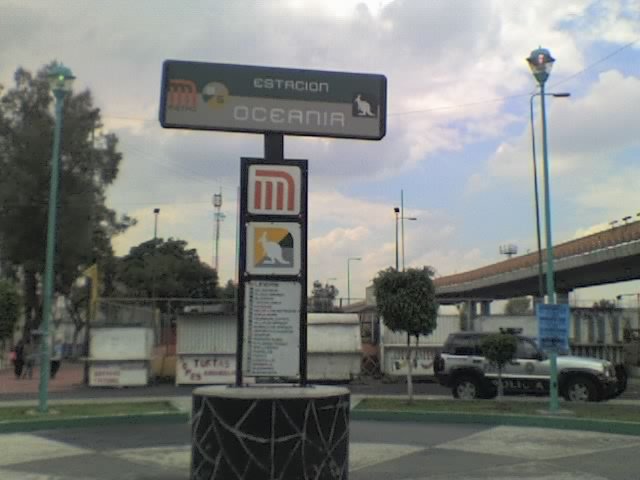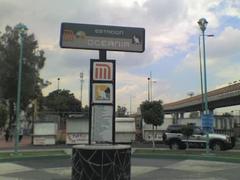
Oceanía Mexico City: Visiting Hours, Tickets, and Historical Sites Guide
Date: 14/06/2025
Introduction to Oceanía Mexico City: Urban Gateway and Cultural Crossroads
Located in the eastern part of Mexico City, Oceanía is a dynamic neighborhood that reflects the city’s transformation from pre-Hispanic lakebed to a bustling metropolis. Once part of the ancient Lake Texcoco, Oceanía’s landscape has evolved through centuries of drainage, urban planning, and development, positioning it as a vital transportation and cultural hub today. With its proximity to Benito Juárez International Airport, excellent metro connectivity, and a blend of traditional markets and modern centers like Encuentro Oceanía, the neighborhood serves as both a practical gateway for travelers and a window into the everyday life of Mexico City residents.
This comprehensive guide explores Oceanía’s historical roots, urban significance, and up-to-date visitor information—including hours, ticketing, accessibility, and nearby attractions. Whether you’re a history buff, a shopper, or a curious traveler, this resource will help you navigate Oceanía with confidence. For more in-depth information, consult Rough Guides, Delineator Design, and the Mexico City Official Guide.
Table of Contents
- Introduction
- Pre-Hispanic and Colonial Foundations
- Urbanization and Growth in the 20th Century
- Infrastructure and Connectivity
- Demographics and Social Fabric
- Environmental and Urban Challenges
- Cultural and Community Significance
- Practical Visitor Information
- Encuentro Oceanía Shopping and Cultural Center
- Nearby Historical and Cultural Sites
- Shopping, Entertainment, and Transportation Guide
- Visitor Tips and Accessibility
- Frequently Asked Questions
- Summary and Recommendations
- Sources and Official Links
Pre-Hispanic and Colonial Foundations
Oceanía rests on land that once formed part of the vast lakes and marshes of the Valley of Mexico. Before the Spanish conquest, Lake Texcoco dominated the area, with the Aztec capital, Tenochtitlán, nearby. The region was characterized by chinampas—ingenious agricultural platforms floating on the water—which were essential to the Aztecs’ farming and food systems (Rough Guides).
Following the Spanish conquest in 1521, extensive drainage projects began to reclaim the lake for settlement and agriculture. By the 19th century, the area was largely rural, but it was poised for significant urban transformation as Mexico City grew (National Geographic Blog).
20th Century Urbanization and the Birth of Oceanía
The mid-20th century saw rapid population growth and urban sprawl in Mexico City. With the opening of Mexico City International Airport (Aeropuerto Internacional Benito Juárez) in 1952, neighborhoods like Oceanía began to urbanize quickly (New Geography). Formal city planning and informal settlements expanded side by side, transforming the former lakebed into a mixed-use urban zone.
By the late 20th century, Oceanía had become a key residential and commercial area, strategically positioned near major roads, the airport, and public transportation (National Geographic Blog).
Urban Evolution: Infrastructure and Connectivity
Oceanía’s rise is closely tied to Mexico City’s infrastructure modernization. The construction of the Circuito Interior (Inner Loop) and the arrival of Metro Line 5 in 1981 strengthened Oceanía as a transportation interchange (Mexico City Official Guide). The Oceanía Metro station now connects residents and visitors to downtown, the airport, and other key districts.
Development included both planned subdivisions and informal housing, reflecting the neighborhood’s role as a destination for internal migrants seeking opportunity.
Demographic and Social Dynamics
Between 1990 and 2014, Mexico City’s population surged, and urban expansion accelerated (New Geography). Oceanía, straddling the Gustavo A. Madero and Venustiano Carranza boroughs, became home to a diverse, working- and middle-class community. Its affordable housing and job access attracted residents from various regions of Mexico and Central America, enriching the area’s cultural life.
Urban Challenges and Environmental Legacy
Built on the old lakebed, Oceanía faces ongoing challenges such as subsidence (ground sinking) and flooding due to groundwater extraction (Rough Guides). Infrastructure upgrades, water management, and urban renewal projects are active, aiming to address these persistent issues. The neighborhood benefits economically from the airport but also contends with noise and air quality concerns.
Cultural and Urban Significance
Oceanía may not have the colonial monuments of the city center or the bohemian culture of Coyoacán, but it offers a genuine glimpse into Mexico City’s everyday life. Key community spaces include Parque Deportivo Oceanía and Mercado Oceanía, while streets reflect a blend of mid-century housing and modern commercial development. The area’s status as a transportation hub highlights the city’s constant movement and urban energy (Lonely Planet).
Practical Visitor Information: Hours, Tickets, and Accessibility
- Markets: Mercado Oceanía typically operates from 7 AM to 7 PM (hours may vary).
- Parks: Parque Deportivo Oceanía is open daily from 6 AM to 9 PM.
- Public Transit: Metro Line 5 and several bus routes serve the area; the Oceanía Metro station is equipped for accessibility.
- Entry Fees: Most public spaces, including markets, parks, and the metro, are free or require only a nominal transit fare.
- Tours: Guided tours may include Oceanía as part of broader explorations of Mexico City’s eastern neighborhoods.
- Photographic Spots: Vibrant markets, green parks, and the bustling metro interchange offer excellent photo opportunities.
- Nearby Attractions: Explore neighboring districts such as Aragón Forest and Cuautepec for nature and culture.
Welcome to Encuentro Oceanía: A Shopping and Lifestyle Destination
Encuentro Oceanía is a super-regional shopping and cultural center that opened in 2021, redefining urban life in northeastern Mexico City (Delineator Design). The center’s prime location—just 5 km from the Zócalo and 2 km from the airport—makes it exceptionally accessible (Mexico City CDMX).
Design and Features
Designed by Estudio Lemus Architects, Encuentro Oceanía combines indoor and outdoor spaces, maximizing natural light and creating communal patios. The central Camino Central area celebrates Mexican culture and provides a welcoming environment for all visitors.
Visiting Hours and Accessibility
- Hours: Daily, 11 AM – 9 PM.
- Admission: Free entry; special events may require separate tickets.
- Accessibility: Fully wheelchair accessible; ample parking for cars and bicycles; adjacent to Romero Rubio metro station (Mexico City CDMX).
Key Anchors and Attractions
- IKEA: The first in Mexico, spanning 23,000 m² over three levels (Wikipedia).
- Chedraui Hypermarket, Cinemex Multicinemas, Energy Fitness, Forever 21: A diverse mix of retail and entertainment.
- Events: Regular cultural events and festivals; check the official website for schedules.
Community Impact
Encuentro Oceanía has revitalized the area, introducing open public spaces and boosting local commerce. While it drives economic growth, it also raises questions about gentrification and community preservation (IR Review). Visitors are encouraged to support both new and traditional local businesses.
Exploring Nearby Historical and Cultural Sites
While Oceanía itself has few traditional monuments, its location provides easy access to several significant sites:
- Glorieta Plaza África: Noted for its unique sculptures.
- Peñón de los Baños Medicinal Baths: Historic thermal baths.
- Mercado San Juan de Aragón: A lively traditional market (Mexico City CDMX).
The Centro Histórico, home to the Zócalo, Templo Mayor, and Palacio de Bellas Artes, is less than 30 minutes away by metro.
Shopping, Entertainment, and Transportation Guide
Shopping
- Plaza Tezontle: Over 200 stores, international and local brands, and a large food court.
- Mercado Jamaica: Famed for flowers, produce, and crafts.
- Mercado Sonora: Known for herbal remedies and folk items.
- Specialty Shops: Bakeries, jewelry boutiques, and mezcalerías like Mis Mezcales (Wheatless Wanderlust).
- Bookstores: Visit Un Paseo Por Los Libros near the Zócalo (Mental Floss).
Entertainment
- Bosque de Aragón: One of the city’s largest parks, ideal for walking, boating, and cultural events.
- Cinemas/Theaters: Modern multiplexes and venues like Foro Cultural Azcapotzalco.
- Nightlife: Head to Roma Norte or Condesa for bars, cantinas, and taquerias (Sally Sees).
- Unique Metro Experiences: Art installations at La Raza and karaoke at División del Norte (Mental Floss).
Transportation
- Metro: Lines 5 and B connect to key destinations (Metro CDMX Map).
- Buses and RTP: Serve areas not reached by metro.
- Taxis/Ride-sharing: Uber, Didi, and Beat are recommended.
- Airport Access: Oceanía is two stops from the airport on Line 5.
- Cycling: EcoBici bike-sharing stations are nearby.
Visitor Tips and Accessibility
- Safety: Keep belongings secure, especially in crowded places; avoid isolated areas at night (Let’s Travel to Mexico).
- Weather: June brings warm days and afternoon showers—carry rain gear.
- Payments: Markets prefer cash; cards accepted in malls.
- Language: Basic Spanish is helpful; translation apps can assist.
- Accessibility: Metro stations are generally equipped with elevators and tactile paving.
Frequently Asked Questions (FAQ)
Q: What are the main visiting hours for Oceanía and Encuentro Oceanía?
A: Oceanía metro operates 5:00 AM–midnight. Markets and parks are open early to evening. Encuentro Oceanía is open 11:00 AM–9:00 PM.
Q: Are tickets required for entry?
A: Entry to markets, parks, and Encuentro Oceanía is free. Some events or museums may require tickets.
Q: How do I reach Oceanía from the airport?
A: Take Metro Line 5 one stop from Terminal Aérea station or use authorized taxis.
Q: Is Oceanía accessible for travelers with disabilities?
A: Yes, the metro and many public spaces offer accessibility features, though some sidewalks may be uneven.
Q: What are the best nearby historical sites?
A: Centro Histórico, Glorieta Plaza África, and Mercado San Juan de Aragón are easily accessible.
Summary and Visitor Recommendations
Oceanía embodies Mexico City’s ongoing evolution—from its Aztec roots as a lakebed to a vibrant transportation and community hub. The neighborhood’s mid-century architecture, bustling markets, green spaces, and major developments like Encuentro Oceanía offer a multifaceted urban experience. With excellent transport links, proximity to the airport, and a wide array of shopping, dining, and cultural activities, Oceanía is both a practical gateway and a destination for those seeking authentic urban life.
Plan your visit to explore Oceanía’s diverse offerings, and use the Audiala app for real-time updates and local tips. Stay connected with Mexico City’s vibrant neighborhoods to make the most of your travel.
Sources and Official Links
- Rough Guides: Exploring Oceanía
- National Geographic Blog: Urban Growth of Mexico City
- IR Review: Gentrification and Economic Growth in Mexico City
- Delineator Design: Encuentro Oceanía
- Encuentro Oceanía - Wikipedia
- Mexico City CDMX: Encuentro Oceanía Venue Page
- Mexico City Official Tourism
- Metro CDMX Map and Transit Information
- Voyage Mexique: Practical Tips for Tourists
- Lonely Planet: Best Neighborhoods in Mexico City
- New Geography: Expanding Productive Mexico City
- Wheatless Wanderlust: 4 Days in Mexico City
- Mental Floss: Must-Visit Stops on Mexico City’s Metro
- Sally Sees: Mexico City Itinerary
- Let’s Travel to Mexico: Visiting Mexico City in June











































































































































































